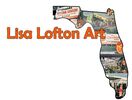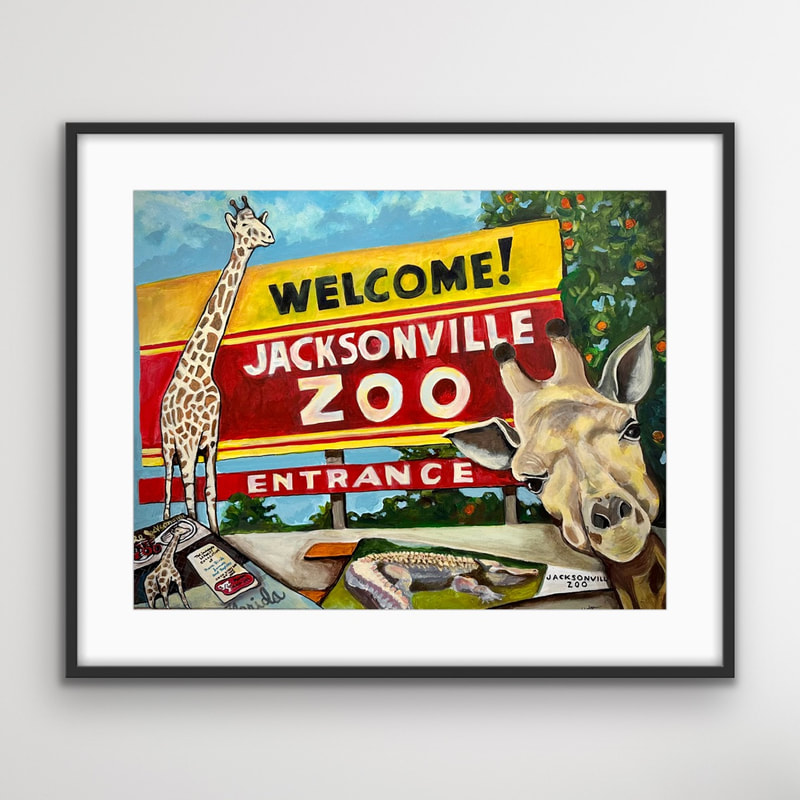JAX CITY HALL EXHIBITION
“Jax Zoo Giraffe Photo-bomb"
16 x 20 framed print
Price $95
16 x 20 framed print
Price $95
The sign in this picture is of the billboard outside the Jacksonville Zoo in the 60s. I ordered an old brochure and pennant from those days to have something tangible to help with my creation. I loved the photo I had of the giraffe and just turned him sideways like he was peeking into the frame photo bomb fashion. He's a little annoyed, but I think it amusing.
The Municipal Zoo opened in the Springfield neighborhood of Jacksonville, Florida, on May 12, 1914. The first animal on exhibit was a red fawn deer.
On July 19, 1925, the zoo moved to a 37.5-acre (152,000 m2) site on the Trout River off Heckscher Drive in the city's Northside area.
Perhaps the most significant animal in the zoo's history was a jaguar named Zorro. Zorro was a male, wild-born black (melanistic) jaguar that arrived at the zoo in August 1967. At that time, black jaguars were very rare in captivity. During Zorro's 19 years at the zoo (he died in September 1986), he fathered numerous cubs sent to other zoos across North America. In the spring of 2003, the Jax Zoo investigated and could not find a current North American captive-born black jaguar who was not a Zorro descendant.
By the end of the 1960s, the zoo was reputed to have the largest collection of exotic animals in the Southeast, but it had fallen on hard times and a great deal of money was needed to save the zoo. Under Mayor Hans Tanzler's direction, community leaders appointed a seven-member committee to search for an alternative to closing the zoo.
A major redevelopment of the zoo began in 1992. Through public funds and private donations, over $20 million was raised. Projects completed include a new front entry gate and parking lot, the Main Camp entrance, Birds of the Rift Valley Aviary, Great Apes, an expanded train ride, an elephant and breeding complex, River Branch Foundation Animal Medical Center, the PepsiCo Foundation Education Campus, and redevelopment of the 11-acre (45,000 m2) Plains of Eash Africa. Exhibits include Stingray Bay, Tuxedo Coast, the Asian bamboo garden, and the Komodo dragon exhibit. (Wikipedia Referenced)
The Municipal Zoo opened in the Springfield neighborhood of Jacksonville, Florida, on May 12, 1914. The first animal on exhibit was a red fawn deer.
On July 19, 1925, the zoo moved to a 37.5-acre (152,000 m2) site on the Trout River off Heckscher Drive in the city's Northside area.
Perhaps the most significant animal in the zoo's history was a jaguar named Zorro. Zorro was a male, wild-born black (melanistic) jaguar that arrived at the zoo in August 1967. At that time, black jaguars were very rare in captivity. During Zorro's 19 years at the zoo (he died in September 1986), he fathered numerous cubs sent to other zoos across North America. In the spring of 2003, the Jax Zoo investigated and could not find a current North American captive-born black jaguar who was not a Zorro descendant.
By the end of the 1960s, the zoo was reputed to have the largest collection of exotic animals in the Southeast, but it had fallen on hard times and a great deal of money was needed to save the zoo. Under Mayor Hans Tanzler's direction, community leaders appointed a seven-member committee to search for an alternative to closing the zoo.
A major redevelopment of the zoo began in 1992. Through public funds and private donations, over $20 million was raised. Projects completed include a new front entry gate and parking lot, the Main Camp entrance, Birds of the Rift Valley Aviary, Great Apes, an expanded train ride, an elephant and breeding complex, River Branch Foundation Animal Medical Center, the PepsiCo Foundation Education Campus, and redevelopment of the 11-acre (45,000 m2) Plains of Eash Africa. Exhibits include Stingray Bay, Tuxedo Coast, the Asian bamboo garden, and the Komodo dragon exhibit. (Wikipedia Referenced)

